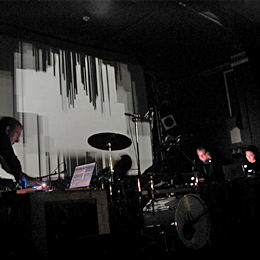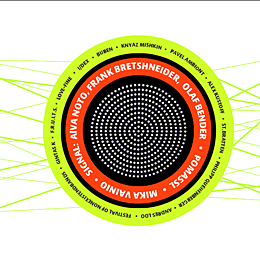

2003.11.27 — @c + Lia + Andy Gangadeen live at the Atlantic Waves Festival, 93 Feet East, London
Soon in Crónica: Marc Behrens’ Compilation Works 1996-2005

More Crónica releases available at Zero Inch

@c, Stephan Mathieu and Janek Schaefer, Ran Slavin are now also available for digital purchase through Zero Inch. More releases will be available soon.
“Up, Down, Charm, Strange, Top, Bottom†reviewed by Liability

Alors que nous avions laissé Miguel Carvalhais et Pedro Tedula (aka @C) sur une belle collaboration en début d’année avec Vitor Joaquim sur le label Feld, les revoilà de retour au bercail pour un nouvel album qui s’annonce aussi sobre et mystérieux que sa pochette. En fait @C est assez fidèle à lui même. On reste dans une abstraction sonore totale où le click’n’cut est partout présent et qui se complait dans un minimalisme inquiétant et des formes très urbaines. Pour autant les deux hommes ne sont pas des adeptes du tout électronique. Ils n’hésitent pas à faire intervenir, comme sur 61, des voix, des percussions, une guitare, un saxophone ou un violoncelle électrique. Ces interventions sont, comme il se doit, d’un ascétisme confondant venant mettre du relief sur des nappes froides et épaisses. Enregistré entre 2006 et 2008 aux quatres coins du globe ce disque est largement axé sur l’accident sonore et une volonté de non répétition des séquences. Nous avançons donc dans ce disque dans une stricte inconnue dont le point d’orgue est tenu par ce long 61 qui s’avère être des plus surprenant.
Quoi qu’il en soit @C fonctionne comme n’importe quelle formation de musiques improvisées. Le modus operandi semble être identique et la volonté de repousser les frontières du monde connu est manifeste. Mais ici on rencontre tout de même le même type d’effort aperçu sur De-Tour, l’album enregistré avec Vitor Joaquim. @C suit donc la même logique, explore avec une conviction identique les possibilités permises par leurs instrument. Doit-on en penser pour autant que le duo se borne à faire à chaque fois le même disque ? Non, à partir du moment où chacune de leur réalisation seront les représentations d’une cohérence artistique forte, il n’y aura pas à douter du travail des deux hommes. Ainsi sur Up, Down, Charm…le caractère abstrait de chacune des plages est produit de manière qui ne laisse aucun doute sur leur profond engagement. Comme beaucoup de leurs collègues qui oeuvrent dans les sphères, Carvalhais et Tedula expérimentent en se souciant d’être au-delà du simple bidouillage. C’est sans doute ce qui fait la différence. Fabien
via Liability
“Praxis†reviewed by Paris Transatlantic

Previously unknown to yours truly, Cem Güney tackles several aspects of computer music with the right amount of profundity, the fragmentary nature of Praxis revealing itself as a value rather than a defect. In the press release the Turkish composer tries to focus our attention on the meditative qualities of certain kinds of sound by relating these features to the teachings of Nada Yoga, which enhances humans’ awareness and response to predetermined acoustic phenomena – but this is neither a series of never ending “Om” nor something even remotely philosophica. Seriously enthralling moments exist, one of them being the evocative “Undulations” – appropriately dedicated to Janek Schaefer – which flows from damaged vinyl into a balance-altering decentralization of personal certainties. Güney is also eager to experiment with quick cut’n’paste (“A Phonetics Theme”), but what he does best is sowing the seed of his interest in a well demarcated range of frequencies and developing the whole investigation from there, the essential nucleus of the piece discernible from beginning to end. This is an album that discloses new meanings with each listen, definitely worth of attentive consideration. Loudspeaker listening is recommended for better interaction with the surrounding environment.–MR
Gintas K live in Minsk

Alva Noto, Frank Bretschneider, Signal, Mika Vainio, Pomassl, Gintas K, Buben, Pavel Ambiont, I/DEX, Love-Fine, CM Von Hausswolff, Spit It Out, F.R.U.I.T.S., Zavoloka, Alois Huber and many others will be performing at the First Experimental Music and Media Art Festival in Minsk, Belarus. Crónica’s own Gintas K will perform on Saturday 28 February at the club Fabrique.
More info at intouch-fest.h-a-z-e.org
New Crónicaster: Innen & Auren

Franke, Neumann, Schmidt, Weinheimer: INNEN & AUREN
The piece INNEN & AUREN is a mixed and edited version of the concert INNEN & AUßEN, that took place as AlulaTonSerien.Konzert #35 at the New Building of the Gallery for Contemporary Art in Leipzig, Dec. 15, 2007. Neumann, who edited it, translated the spatial experience of the live concert to this stereo version. The chronological order of the concert was kept, but condensed. No sounds or effects were added.
For the original concert, the four performers created a set-up, which took place in three rooms inside the gallery and outside the gallery. Each of the four performers had his own position and function within the set-up and with each position made a certain statement about the relationship between inside and outside.
The set-up included: a microphone outside of the gallery (Franke, outside), speakers behind a glass wall, microphone in room 1, feed from Franke and computer (Neumann, room 1), speakers outside the gallery and in room 1, two headphones in room 3, microphone, sine wave generator, feed from Franke and computer (Schmidt, room 3), four speakers in room 1, one speaker outside the gallery, violin, bass flute with internal microphones and electronics (Weinheimer, room 1).
“Digital Sound Drawings†reviewed by soundproector

Stunning net release by the Portuguese label Crónica is the result of musician/designer from Denmark Morten Riis’s creative work. His album Digital Sound Drawings is a real finding for people who are fond of phenomenon in electronic music which is accepted to be called ‘glitch’. As Riis himself admitted, he is not interested in creating electronic music using the standard capacity of program facilities. He searches for that very moment when a computer error doesn’t yet cause the collapse of the system, but it already makes the machine give unpredictable and that’s why absolutely unique result.
In Digital Sound Drawings the scheme of direct conversion of digital pictures into audio data is used. It means that the musician actually painted the sound for this not long 6 tracks. As a result we have very amusing pictures of clicks, drones, squeak and gritting which balance on the verge of hearing threshold. Together they produce only total recalibration of auditory system. The real chance to feel as if an experimental object in this activity. Especially when while the album’s playing you look at the spectrogram and oscillogram of the signal you understand that you are influenced by some new sound system. Or rather some subsystem hidden inside the structure of any complicated sound. When I was listening to Digital Sound Drawings first very loudly, several times I felt hot and cold. The same was the organism’s reaction to the abrupt amplitude changes and to the general unnatural audio surrounding. I must admit that for many people the album will seem to be a sharp and maybe unpleasant collection of sounds. This is a very complicated work, not dry, dirty noise or predictable collage of loops. For those who’ll be imbued with this album contains something more – new sounds, new emotions and the change of world-view…
via soundproector
“Ification†reviewed by Earlabs

Pure is Austrian born and Berlin based Peter Votava, who stepped into the music business somewhere in the beginning of the nineties. Since then, he has released many CD’s and 12†vinyls – his roots actually lie in DJ culture and as such he has established himself already in the hardcore/techno scene. In the mid nineties he was also half of Rave party darlings Ilsa Gold, but nowadays Pure concentrates on the more experimental side of the sound spectrum. A path that culminated in a collaboration with Austrian artist Erich Berger, in 2006. As Terminal Beach they presented their audiovisual performance The Heart Chamber Orchestra: a piece for orchestra (12 musicians equipped with ECG sensors) that uses the musicians’ heartbeats to form a computer generated score for the orchestra in real time (and a visual environment along the way). Besides all this, Pure also continued to produce his solo works. Ification, which is out now on the Portugese Crónica label, is his latest offering.
Ification counts 7 tracks and starts off with an intro titled FIRE. At first I wasn’t too sure what to think of this track: its necessity went beyond me and the mention that Atari Teenage Rioteer Christoph De Babalon delivered the guitar recording didn’t impress me either. After reading Vital Weekly’s verdict on the record it does seem to make a bit more sense: it’s abrasive shreds of distorted guitar assault do indeed pave the way for the audible contemplation presented in the second track (AFTER THE BOMB). As if the shells dropped from my ears.
From here on, Pure presents us more explorations into the dark and gloomy regions of sound. APPROXIMATION has a certain bombastique that reminds me of Wagner. Not only because of the slowed down horns: the whole track seems to be composed on a skeleton that indicates a classical approach. Well and successfully executed I’d might say, making it one of the best tracks off the album.
I think the only disappointment here is SONOMATOPEIA. Alexandra von Bolzn’s vocal contributions, or Pure’s processions thereof, do not really have the ability to bleak out William Bennett’s or Kevin Tomkins’ contributions to the Power Electronics genre – although the press release tends to make you believe otherwise. And might I add: a tad bit too much BBC sound effects on display? Well, at least according to my taste that is.
Anyhow, with Ification, Pure delivered another great collection of tracks that soothingly resonate inside your skull. Purification of the soul? I’ll let you decide on the supine ending.
via Earlabs
“Up, Down, Charm, Strange, Top, Bottom†reviewed by Liability
Alors que nous avions laissé Miguel Carvalhais et Pedro Tedula (aka @C) sur une belle collaboration en début d’année avec Vitor Joaquim sur le label Feld, les revoilà de retour au bercail pour un nouvel album qui s’annonce aussi sobre et mystérieux que sa pochette. En fait @C est assez fidèle à lui même. On reste dans une abstraction sonore totale où le click’n’cut est partout présent et qui se complait dans un minimalisme inquiétant et des formes très urbaines. Pour autant les deux hommes ne sont pas des adeptes du tout électronique. Ils n’hésitent pas à faire intervenir, comme sur 61, des voix, des percussions, une guitare, un saxophone ou un violoncelle électrique. Ces interventions sont, comme il se doit, d’un ascétisme confondant venant mettre du relief sur des nappes froides et épaisses. Enregistré entre 2006 et 2008 aux quatres coins du globe ce disque est largement axé sur l’accident sonore et une volonté de non répétition des séquences. Nous avançons donc dans ce disque dans une stricte inconnue dont le point d’orgue est tenu par ce long 61 qui s’avère être des plus surprenant.
Quoi qu’il en soit @C fonctionne comme n’importe quelle formation de musiques improvisées. Le modus operandi semble être identique et la volonté de repousser les frontières du monde connu est manifeste. Mais ici on rencontre tout de même le même type d’effort aperçu sur De-Tour, l’album enregistré avec Vitor Joaquim. @C suit donc la même logique, explore avec une conviction identique les possibilités permises par leurs instrument. Doit-on en penser pour autant que le duo se borne à faire à chaque fois le même disque ? Non, à partir du moment où chacune de leur réalisation seront les représentations d’une cohérence artistique forte, il n’y aura pas à douter du travail des deux hommes. Ainsi sur Up, Down, Charm…le caractère abstrait de chacune des plages est produit de manière qui ne laisse aucun doute sur leur profond engagement. Comme beaucoup de leurs collègues qui oeuvrent dans les sphères, Carvalhais et Tedula expérimentent en se souciant d’être au-delà du simple bidouillage. C’est sans doute ce qui fait la différence.
Fabien
